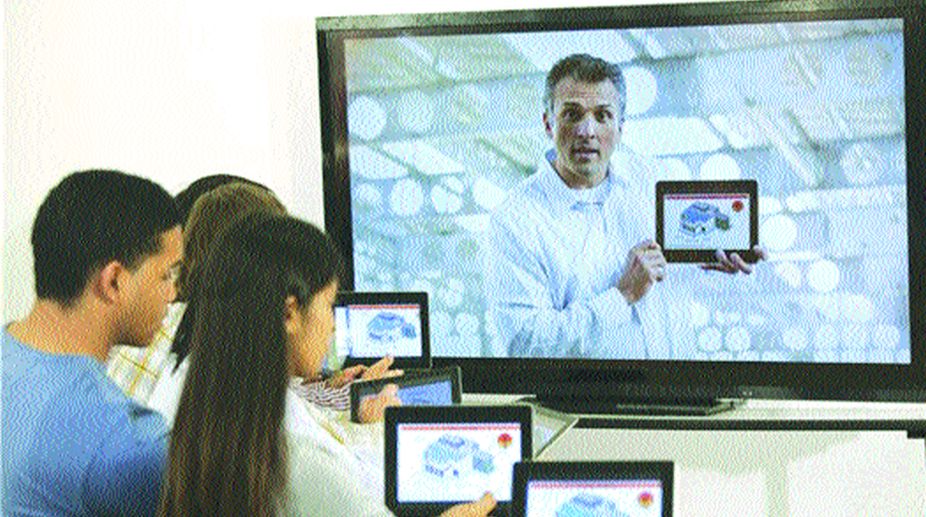With the advent of digital India, the country education system is undergoing a huge revolution. Traditional classrooms are fast getting replaced with digital or smart classes as they are popularly known. According to a recent survey report by the UK-India Business Council, India is the second largest e-learning market globally after the United States.
The recent penetration of internet-based technology is due to the rapid increase of low-cost hand-held devices and smartphones among the younger population giving them access to learning tools, online material, and training providers. This has paved the way to a more sophisticated and flexible kind of learning through virtual classrooms where the students don’t just learn but also engage by practicing, experiencing, and sharing their knowledge on a virtual environment.
A survey says that there are over 20,000 education-based mobile apps and virtual learning programmes available online and about 3, 50,000 ebooks got downloaded from iBooks within the first three days of its launch.
There has been a big debate on the effectiveness of such virtual classrooms and its efficiency in imparting knowledge to the students. However, it has been observed by many that a collaborative learning pattern is superior to traditional classroom teaching as it paves the way for meaningful discussions and active interactions. This style of learning and functioning greatly impacts their ability to cope with the corporate culture prevalent in the companies once they start working.
With the increase in technology, blackboards are getting replaced by projectors to display content from hand-held devices. This saves a lot of time and effort put in by the teachers and also gives them access to a wide range of material they can use to explain the concepts in a more simplistic and engaging way. Students can now navigate through an assortment of tools and media to interact and understand effectively, thus contributing to a shared learning environment. This atmosphere is more positive and engaging with more students coming forward with their opinions and views on topics. Such classrooms are more student-centric and have scope for elaborate discussions and on-the-spot feedback from both the teachers and the students.
Unlike the traditional learning methods, these digital classrooms go beyond textual knowledge and promote out-of-the-box thinking. They prepare the students to think beyond bookish learning and enable them to effectively compete in a global environment. Digital classrooms solve a lot of administrative glitches which would otherwise hamper the learning process. Some of the benefits include:
n Unrestricted classroom timing
Digital learning is a more flexible solution which provides the students with 24/7 tutoring availability and online materials making it easier to learn at their convenience. This is not possible in the traditional classrooms which have strict time schedules with limited scope for discussions and doubt clearing sessions. One can choose to extend or curtail a specific subject timing and focus on one at a time without having to worry about time. They can thus learn at their own free will and pace, making the learning process more interesting and engaging.
n Learning on-the-go
This is the best part of a digital classroom. Students can now choose to study from anywhere and can get unlimited access to digital material without having to actually sit in a classroom environment. The entire curriculum is made flexible and portable making the learning process less burdening. One need not carry heavy and bulky books everywhere before exams to study, thanks to all the virtual books and study materials made available to them. Students can now even catch up on any missed sessions or revise a topic again through the downloadable content and class notes made available virtually.
n Detailed learning process
The interactive and engaging virtual content enables the students to understand the concepts more clearly and focus better. As a result, they have better retention power and don’t require mugging the concepts prior to exams. Virtual classrooms enable them to learn both through the auditory and visual process making learning more fun and interesting.
n Virtual guidance and
learning support
Through digital classrooms, students can get enhanced external guidance and virtual support round the clock for effective learning and resolution of queries making the learning process effective. One can connect with subject experts and counsellors anytime to seek guidance. It also enables vocabulary enhancement and better understanding of concepts and theories.
Learning can be both progressive and fun with digital technology. Though this is in its preliminary phase in India, it has shown tremendous scope and demand among the students making it the best learning mode made available to them, by far. When considering the vast population of students and the considerably low number of quality teachers in India, digital classrooms is the best solution one can think of to curb the increasing challenge of empowering and making learning an engaging and interactive experience.
(THE WRITER IS CO-FOUNDER AND CEO, HELLOCLASS)











